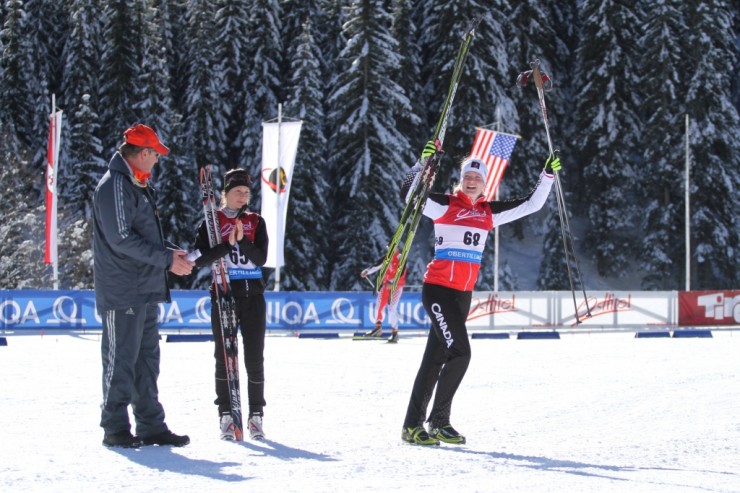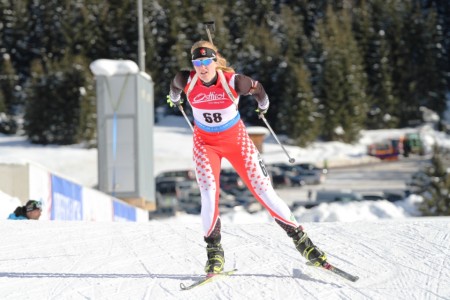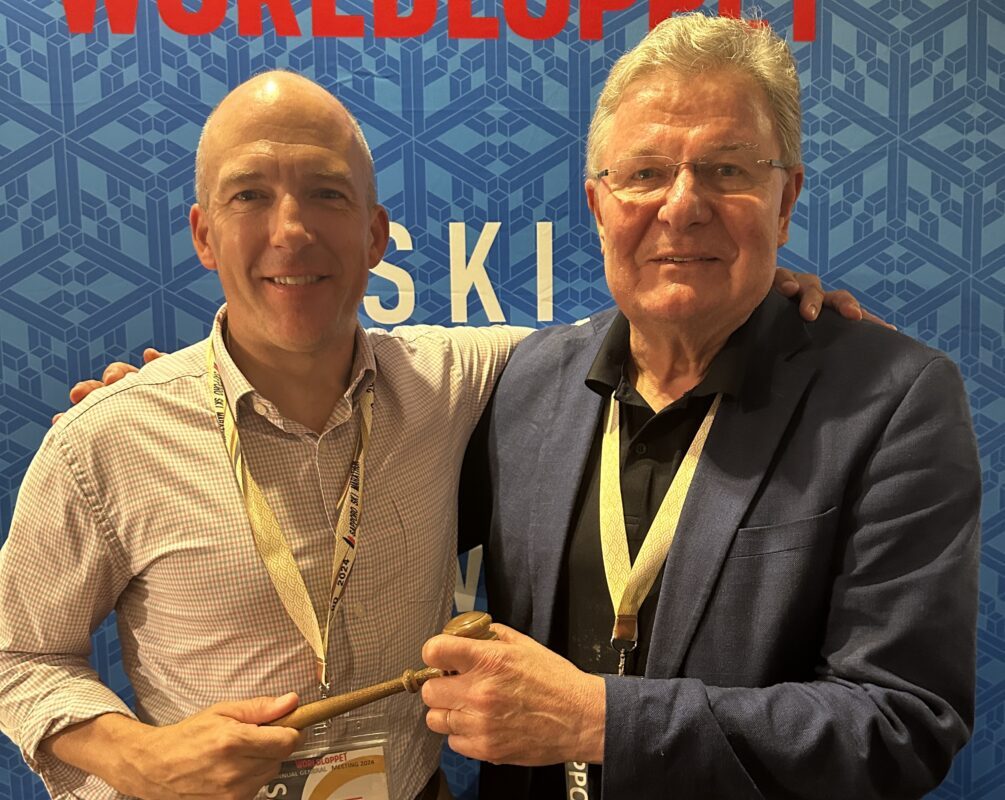
For some North American athletes who earn a trip to World Junior Championships, just making the team is something to celebrate – a long-planned goal, an accomplishment that defines a season.
But once the roster is named, those athletes get serious about what they might accomplish. And this is especially true for those who are returning for their second, or even third or fourth, international tour.
“We had two goals for the Championships,” Biathlon Canada High Performance Director Christ Lindsay told FasterSkier in an interview on Tuesday. “One is in a participatory and preparation context, where we see that athletes who have been exposed to international competition come back refocused, and they know where they are in relation to the rest of the world and are able to use that experience as a springboard for future success. The other side of our goals are in the performance area.”
The team set specific goals for its elite athletes going into World Youth and Junior Championships in Obertilliach, Austria, and Sarah Beaudry of Prince George, British Columbia, had among the toughest of tasks: “For Sarah, the goal was top 12 results,” Lindsay said.
After the sprint and pursuit races this weekend, Beaudry was unsatisfied. A three-time competitor in the youth division of biathlon’s championships, as well as a participant in last season’s Youth Olympic Games, her 36th and 28th-place finishes were solid – but not anything exciting.
“Both the sprint and the pursuit went okay,” she wrote in an e-mail on Monday. “Both days I felt like I wasn’t skiing my best. I was really happy with my shooting in the pursuit but it would have been nice to hit a few more in the sprint. I was definitely hoping for a little bit better results, but I still have the individual tomorrow to improve on my current results.”
Well: mission accomplished. On Tuesday Beaudry jetted into the spotlight, collecting only two penalties in the 10 k pursuit race and placing fifth, 25 seconds off the podium.
“It was more of a fresh start after Friday’s race, where I was very nervous and wasn’t quite feeling quick after the long travel,” Beaudry wrote after the individual. “Surprisingly, I managed to not let my nerves get in the way during the shooting. I knew this was my chance and I knew if I wanted it I would have to shoot well.”

The result was better than any of Beaudry’s previous international races, a testament to how hard she has trained this year. After graduating from high school last spring, she joined the Biathlon Alberta Training Centre in Canmore and has been working full-time with coach Richard Boruta, who is also the head of the Canadian team at the Championships.
That, says Lindsay, has allowed an experienced junior to have the kind of breakthrough that put her so close to the podium even though Beaudry, a strong skier and sprinter in particular, admitted that “I wouldn’t say the individual [where each missed shot is penalized by a minute of added time] would be my strongest format.”
“I do expect my athletes to perform to the level of their abilities, so in that regard I knew that Sarah had the potential to do just that,” Boruta wrote in an e-mail regarding Beaudry’s finish. “However, in biathlon, more than many other sports, it is very difficult to expect podium performances, because in elite racing an error on the shooting range can often cost you as many as 10 or more places. She did today exactly what she has been training for, which for sure is a good thing for her future.”
With one penalty in each standing stage – which came second and fourth out of the four stages – Beaudry was always close to the top. After one stage she ranked sixth and a stage later seventh; for the rest of the race she hovered between fourth and fifth. But although she knew she was having a good race, Boruta didn’t add any pressure by telling her how close she was to the podium.
“In this age group we usually try to keep our athletes on their race plan until the shooting is over,” he explained. “Most of the information is related to ski speed and technique, but we didn’t share with her the exact position. Usually, they will either start skiing too hard or thinking too much and the last shooting is important enough to change the race outcome completely. She knew on the last 2.5 km loop where she is and what she needs to do and she did her best to keep the position.”
The last loop was actually Beaudry’s slowest – try as she might, she couldn’t make up ground. But it didn’t matter, because the next finisher was 20 seconds behind.
“I was definitely tired by the last lap but was feeling a lot better than the other races,” Beaudry wrote.
And she was never in a position to win; Uliana Kaisheva of Russia completed a clean sweep of the youth events, winning by a whopping 1:20 despite two penalties, the same as Beaudry’s score. In fact, both Beaudry’s success and her distance from the winner were characteristic of important lessons that Lindsay hopes Canada’s young athletes will learn. First of all, the best in the world are very, very good. Not only in the youth women’s division, where Kaisheva has dominated, but also in the junior men’s division, a group of athletes have been head and shoulders above the rest.
“We were quite surprised at the level of quality at the very top end,” Lindsay said. “And I think, specifically, with a few of the winning athletes – some of them we’ve already seen – but some of them are now registered for the World senior Championships. But some of them are athletes that we have not seen before in competition. It’s tough, but it’s also a reminder that we can’t be complacent back here. Just because you’re the number one in the U.S., or in Canada, or in North America, really doesn’t give you a good gauge on how you’re going to do when you compete against the Europeans.”
But the second message is hope.
“A lot can happen for an athlete at 17 or 18 years old within six months,” he said. “Just because you feel a little sluggish here doesn’t mean that you can’t become that person who wins the medal.”
And that’s especially important for Beaudry’s teammates. Another top Canadian youth, Danielle Vrielink, broke a bone in her wrist while tobogganing. So the other three members of the youth women’s squad are young – 16 years old, the bottom of the age group as opposed to Beaudry’s 18 years – and have never before raced in Europe.
“I think it is a great eye-opener for these girls and they will have better understanding now what is really expected from athletes competing at this level,” Boruta wrote. “And I believe that it is motivating to see your team-mate do this well, that it is not only a privilege of Germans or Norwegians or Russians.”
Lindsay called Beaudry “a leader,” but said that he was also impressed with the younger athletes: in the individual, for instance, Leilani Tam Von Burg placed 50th, Emily Dickson 54th, and Charlotte Hamel 61st. While Dickson had six penalties, Hamel and Tam Von Burg had just three and four.
“I’m not disappointed by any means with the performances, and quite frankly I’m happy at the number of younger athletes we have there and how they’ve been able to put themselves together to get through races successfully and not have blow-ups, and to be able to learn something,” Lindsay said.
For Beaudry, though, leadership isn’t a chore – it’s a treat.
“It is fun being with the new girls who were all so excited for their first international race and remembering what it was like for me the first time racing in Europe,” she wrote in an e-mail.
* * *
In the youth men’s 12.5 k pursuit, Canada was left without its top racer, Stuart Harden, who Boruta said had “some quite serious health problems” and may or may not be back for the relay.
As such, he had nothing to add when Aristide Begue of France repeated his world title in the event from last season, or when Sean Doherty of the U.S. placed second, collecting his third medal of the championships – a record for a U.S. biathlete.
Instead it was Carsen Campbell leading the way in 37th. After three stages Campbell, of Prince Edward Island, seemed to be headed to his second top-30 finish of the Championships, but two more penalties in the last stage dropped him down the list.
“He started with two misses in first prone, which in this type of race is very discouraging,” Boruta wrote. “You have to be very good skier to keep the hope of having a good result with so many shooting penalties. He doesn’t have much perspective about how well you actually need to ski at this level, so he will probably learn a lot. He is also interacting with other athletes and it helps him to become better athlete himself.”
Matthew Strum placed 67th and Arthur Roots 86th to round things out for Canada.
Chelsea Little
Chelsea Little is FasterSkier's Editor-At-Large. A former racer at Ford Sayre, Dartmouth College and the Craftsbury Green Racing Project, she is a PhD candidate in aquatic ecology in the @Altermatt_lab at Eawag, the Swiss Federal Institute of Aquatic Science and Technology in Zurich, Switzerland. You can follow her on twitter @ChelskiLittle.



